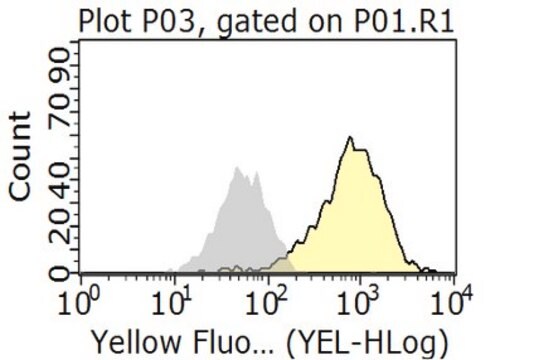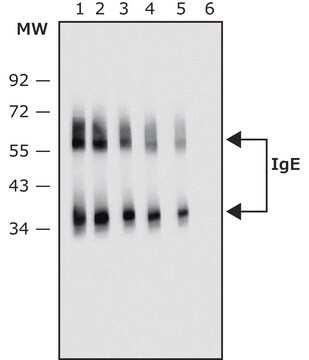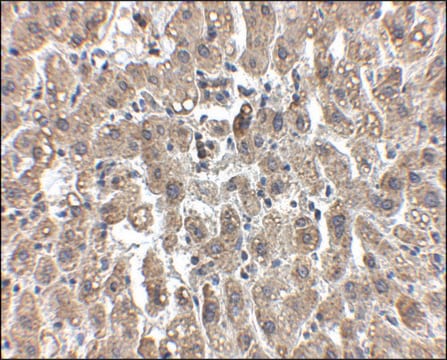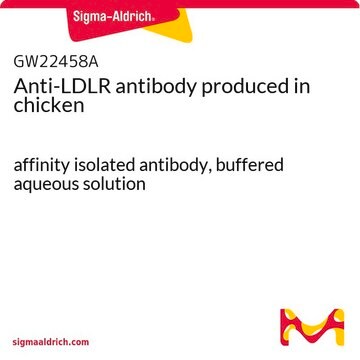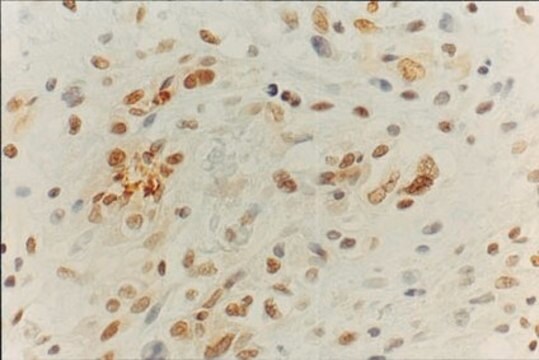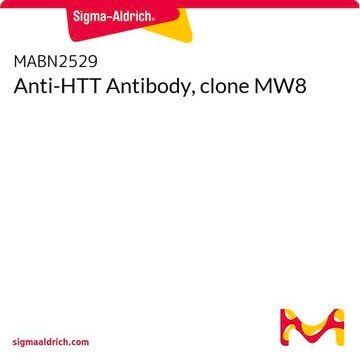General description
We are committed to bringing you greener alternative products, which adhere to one or more of The 12 Principles of Green Chemistry.This antibody is Preservative-free, produced without the harm or sacrifice of animals and exceptionally stable to allow for ambient shipping and storage if needed and thus aligns with "Waste Prevention", "Designing Safer Chemicals" and "Design for Energy Efficiency".
Click here for more information.
ZooMAb antibodies represent an entirely new generation of recombinant monoclonal antibodies.
Each ZooMAb antibody is manufactured using our proprietary recombinant expression system, purified to homogeneity, and precisely dispensed to produce robust and highly reproducible lot-to-lot consistency. Only top-performing clones are released for use by researchers. Each antibody is validated for high specificity and affinity across multiple applications, including its most commonly used application. ZooMAb antibodies are reliably available and ready to ship when you need them.
Learn more about ZooMAb here.Specificity
Clone 2N19 is a ZooMAb rabbit recombinant monoclonal antibody that specifically detects LDL receptor. It targets an epitope within 105 amino acids from the C-terminal region.
Immunogen
His-tagged recombinant fragment corresponding to 105 amino acids from the C-terminal region of human LDL receptor.
Application
Anti-LDL Receptor, clone 2N19 ZooMAb , Cat. No. ZRB1176, is a highly specific rabbit recombinant monoclonal antibody that targets Low-Density Lipoprotein Receptor and has been tested for use in Flow Cytometry, Immunocytochemistry, Immunohistochemistry, and Western Blotting.
Western Blotting Analysis: A 1:1,000 dilution from a representative lot detected LDL Receptor in RAW264.7 and HEPG2 cell lysates.
Immunohistochemistry (Paraffin) Analysis: A 1:100-1,000 dilution from a representative lot detected LDL Receptor in human liver and rat liver tissue sections.
Immunocytochemistry Analysis: A 1:100 dilution of from a representative lot detected LDL Receptor in A431, HepG2, NIH 3T3 cells.
Flow Cytometry Analysis: 0.1 μg from a representative lot detected LDL Receptor in HepG2.
Note: Actual optimal working dilutions must be determined by the end user as specimens and experimental conditions may vary.
Target description
Low-density lipoprotein receptor (UniProt P01130; also known as LDL receptor) is encoded by the LDLR (also known as FH, FHC) gene (Gene ID: 3949) in human. LDL receptor is a single-pass type I membrane protein that is rapidly endocytosed upon ligand binding. It binds low density lipoprotein (LDL) and transports it into cells by endocytosis. LDL receptor recognizes the apoprotein B100 embedded in the outer phospholipid layer of cholesterol-rich LDL particles and mediates their removal by endocytosis via clathrin-coated pits. It also recognizes the ApoE protein found in chylomicron remnants and VLDL remnants (IDL). LDL receptor is synthesized with a signal peptide (aa 1-21), which is subsequently cleaved off to generate the mature form. The mature form of LDL receptor contains an extracellular domain (aa 22-788), a transmembrane domain (aa 789-810), and a cytoplasmic domain (aa 811-860). The extracellular region contains seven class A (aa 25-313) and six class B (aa 397-658) LDLR repeats and three EGF-like domains (aa 314-353, 354-393, 663-712). LDL-A repeats are known to mediate LDL binding, and repeats 2-7 are required for ApoB binding, while only repeat 5 is required for ApoE binding. The class B (LDL-B) repeats region adopts a beta-propeller conformation and is believed to be responsible for the pH-dependent release of LDL in the endosome. The cytoplasmic tail contains a signal sequence that is important for localizing the receptors to clathrin-coated pits and for triggering receptor-mediated endocytosis upon LDL binding. Mutations in LDLR gene are known to cause familial hypercholesterolemia (FH) leading to high levels of serum LDL and excess deposition of cholesterol in tissues leading to atherosclerosis and higher risk of premature coronary heart disease. This ZooMAb recombinant monoclonal antibody, generated by our propriety technology, offers significantly enhanced specificity, affinity, reproducibility, and stability over conventional monoclonals.
Physical form
Purified recombinant rabbit monoclonal antibody IgG, lyophilized in PBS with 5% Trehalose. Normal appearance is a coarse or translucent resin. Contains no biocide or preservatives, such as azide, or any animal by-products. Larger pack sizes provided as multiples of 25 μL.
Reconstitution
Reconstitute lyophilized antibody pellet with 25μL of ultrapure water or Phosphate Buffered Saline (PBS). Please refer to our
reconstitution protocol and the specific application guidance on the suggested starting dilutions and sample type.
Storage and Stability
Recommend storage of lyophilized product at 2-8°C; Before reconstitution, micro-centrifuge vials briefly to spin down material to bottom of the vial; Reconstitute each vial by adding 25 μL of filtered lab grade water or PBS; Reconstituted antibodies can be stored at 2-8°C, or -20°C for long term storage. Avoid repeated freeze-thaws.
Legal Information
ZooMAb is a registered trademark of Merck KGaA, Darmstadt, Germany
Disclaimer
Unless otherwise stated in our catalog or other company documentation accompanying the product(s), our products are intended for research use only and are not to be used for any other purpose, which includes but is not limited to, unauthorized commercial uses, in vitro diagnostic uses, ex vivo or in vivo therapeutic uses or any type of consumption or application to humans or animals.


